JE Audio HP10 Phono Amplifier
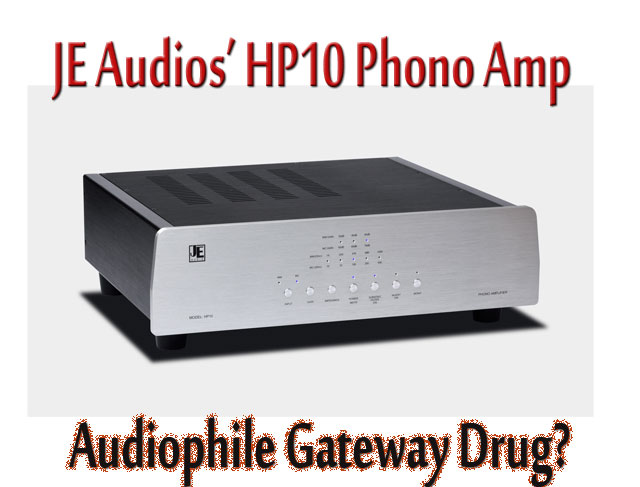
 Is it possible to get a high from listening to an audio system? I remember doing a paper in college on the subject of drug addiction and how it manifests itself, particularly addiction via so called “gateway” drugs such as marijuana. I watched all manner of on-line video interviews with past and current heroin addicts and read some startling stories of what it’s like to become addicted. But there was one line from an anonymous writer that really stuck with me: “Being high on heroin is like being cradled to sleep by God, wrapped up in a warm luxurious blanket that shields you from all your worldly fears, angers, and pains.” That struck me as a very powerful and poignant statement. Obviously, I’m not advocating heroin use but I found the idea that using anything that could elicit such a response, interesting, to say the least.
Is it possible to get a high from listening to an audio system? I remember doing a paper in college on the subject of drug addiction and how it manifests itself, particularly addiction via so called “gateway” drugs such as marijuana. I watched all manner of on-line video interviews with past and current heroin addicts and read some startling stories of what it’s like to become addicted. But there was one line from an anonymous writer that really stuck with me: “Being high on heroin is like being cradled to sleep by God, wrapped up in a warm luxurious blanket that shields you from all your worldly fears, angers, and pains.” That struck me as a very powerful and poignant statement. Obviously, I’m not advocating heroin use but I found the idea that using anything that could elicit such a response, interesting, to say the least.
 But the more I thought about it, there actually is a subgroup of audiophiles who routinely echo such responses to questions about the sound of their systems. They’re called “analog-tubeophiles.” You’d recognize them by the piles of vinyl LPs and various brands of output tubes that are usually scattered about their listening rooms. Not to mention the posters of Conrad Johnson and Audio Research gear that adorn their listening room walls. The real hardcore ones usually have some version of the Linn LP12 lying around unused along with bits and pieces of various cartridges. All are unwaveringly devoted to analog music reproduction and are constantly in search of components with the “tube sound.”
But the more I thought about it, there actually is a subgroup of audiophiles who routinely echo such responses to questions about the sound of their systems. They’re called “analog-tubeophiles.” You’d recognize them by the piles of vinyl LPs and various brands of output tubes that are usually scattered about their listening rooms. Not to mention the posters of Conrad Johnson and Audio Research gear that adorn their listening room walls. The real hardcore ones usually have some version of the Linn LP12 lying around unused along with bits and pieces of various cartridges. All are unwaveringly devoted to analog music reproduction and are constantly in search of components with the “tube sound.”
So what is it about tubed analog products that create such an emotional connection between these music lovers and their systems? I’m not sure, but when I was offered an opportunity to spend some time with the JE Audio HP10 phono amp, I suspected that I would soon find out.
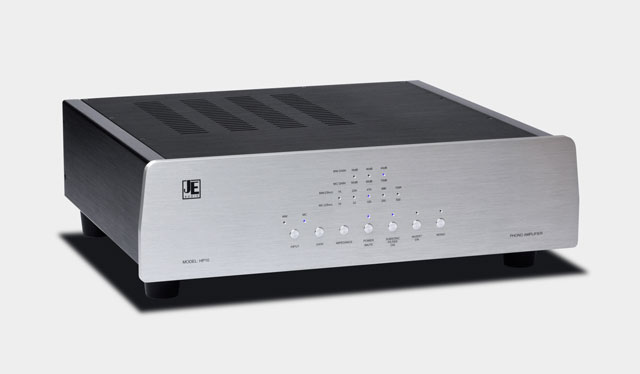
The HP10
JE Audio is a ten year old company, founded by John Lam, the company’s chief designer. My initial experience with the company came a few years ago when my brother and fellow Stereo Timer, Mike Wright was reviewing the company’s Dyad S400 amplifier for Ultra Audio. I remember spending a long evening with Mike listening to everything we could get our hands on. This was one of those products that the longer you listened to it the more it got into your soul. I remember summing up my experience by saying that what it lacked in visual appeal it more than made up for in what it does for music.
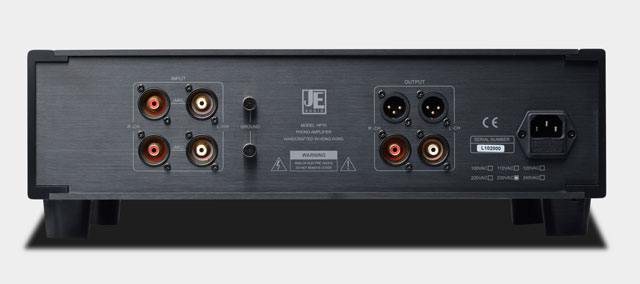
Aesthetically, the HP10 has a lot in common with the S400. It has a ¼” thick silver brushed aluminum faceplate and a solidly built black chassis. All of the HP10’s functionality can be controlled from the faceplate where you can set the unit’s gain for MC (60, 65 and 70dB) and MM cartridges (35, 40 and 45dB). You can also set the impedance as well. 1K, 22K, 47K, 68K and 100 kOhm for MM and 10, 33, 100, 250 and 500 Ohms for MC. The rear of the unit has RCA inputs for MC and MM cartridges, but a really nice design touch is having both RCA (unbalanced) and XLR (balanced) outputs.
Interestingly, the JE Audio products are not pure tube designs but hybrids that maximize the benefits and detail capabilities of using solid-state semiconductors, but still use tubes in the all-important output stage. In the case of the HP10 it uses a 6H30 tube at each channel because of its wide bandwidth, low distortion and low output impedance characteristics.
According to their websiteThe HP10’s MC and MM input signals are handled by separate MC and MM phono amplifiers. They are independent amplifiers that have no common parts sharing between them. Therefore, this will ensure shortest signal path and no switch is used at the low level input signal.Since these amplifiers are independent, each has its own RIAA equalization. Passive RIAA equalization is used because of its minimal impact on the sound.
System and Set Up
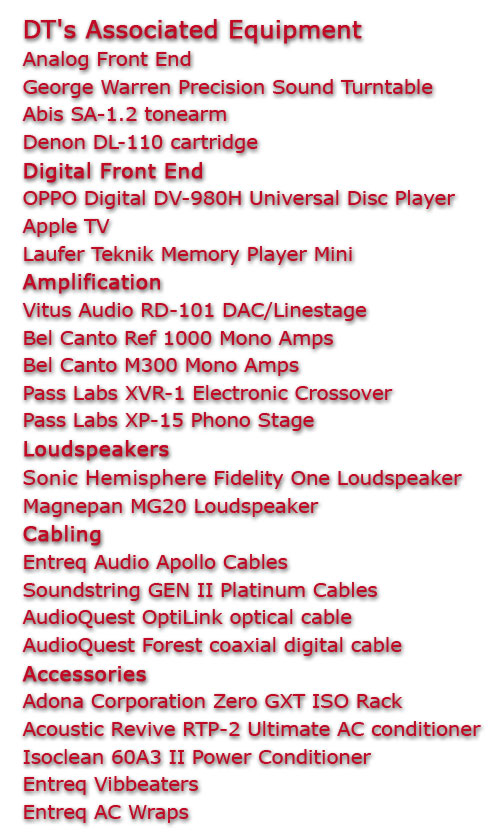 My reference system has been anchored by a pair of Magnepan MG20s being driven by two pairs of Bel Canto mono amps (M300s for the tweeter/midrange. REF1000Ms for the bass). My main digital source is the Laufer Teknik Memory Player Mini and and a OPPO DV980H Universal Disc Player. Both units feed a Vitus Audio RD-101 DAC/linestage. My analog source is still the George Warren turntable/Abis SA-1.2 tonearm combo. I’m currently using a couple of affordable moving coils: The Benz Micro Ace L and super-nuetral Denon DL-110. My reference phonostage for the past few years has been the excellent Pass Labs XP-15. I will go into a comparison with the HP10 shortly. Rounding out my system are Soundstring Gen II Platinum cables and Isoclean 60A3 II Power Conditioner. My listening room is about 26’ wide and 20’ deep with 8” tall ceilings and carpeted concrete floors.
My reference system has been anchored by a pair of Magnepan MG20s being driven by two pairs of Bel Canto mono amps (M300s for the tweeter/midrange. REF1000Ms for the bass). My main digital source is the Laufer Teknik Memory Player Mini and and a OPPO DV980H Universal Disc Player. Both units feed a Vitus Audio RD-101 DAC/linestage. My analog source is still the George Warren turntable/Abis SA-1.2 tonearm combo. I’m currently using a couple of affordable moving coils: The Benz Micro Ace L and super-nuetral Denon DL-110. My reference phonostage for the past few years has been the excellent Pass Labs XP-15. I will go into a comparison with the HP10 shortly. Rounding out my system are Soundstring Gen II Platinum cables and Isoclean 60A3 II Power Conditioner. My listening room is about 26’ wide and 20’ deep with 8” tall ceilings and carpeted concrete floors.
The easy to drive Denon cartridge did not require me to make any adjustment to its gain or impedance settings as it was configured out of the box, so that was the cartridge trhat did most of the heavy lifting. So after a few days of letting it settle into my system I was able to get right into some serious listening.
Serious Listening Begins
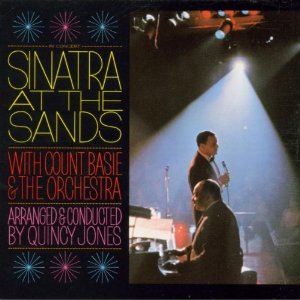
If you’re going to evaluate a phonostage with a tube output, you’ve got to be doing it listening live music as much as possible. There is one recording that our own Norm Luttbeg has used on just about every review he’s written, Sinatra at the Sands, features the Chairman of the Board with the venerable Count Basie Orchestra. I came across a Universal Music vinyl pressing at a Barnes & Noble of all places. I figured that if it’s good enough for Norm, it’s good enough for me. Well, I’m here to tell you, Norm knows his stuff. This is a brilliant album and easily one of the best vinyl recordings I’ve bought in a long time. The entire recording is fabulous from beginning to end but there were a couple of tracks that I kept coming back to.
The first track was “I’ve Got A Crush On You.” This is classic Sinatra: intimate, heartfelt and warm. Warm, in a way that can only be produced by tubes. The HP10 rendered this recording with the type of detail and image specificity that you would expect from a solid-state input. But it’s that little something special that you can only get from tubes that the HP10 excels at. The soundstage is filled with more air. The vocals have more breath. And the venue has a bit more life. These are those things that analog-loving tubeophiles become addicted to.
Another track from this album that I loved was, “You Make Me Feel So Young.” It’s a slightly more up-tempo song that brings your attention to percussions and that great Basie horn section. Through the HP10, the natural characteristics of those instruments comes through in a way that is spine-tingling.
Though not a live recording similar thoughts arose while listening to Kurt Elling’s Flirting With Twilight [Blue Note]. The third track from this album, “You Don’t Know What Love Is,” features Elling at his finest. His distinctive voice really gets rendered in a way that makes the case for why all phono amps should have tube outputs. Air, spaciousness, warmth and realism are hallmarks of what this unit is capable of with well recorded music.
Enter the XP-15
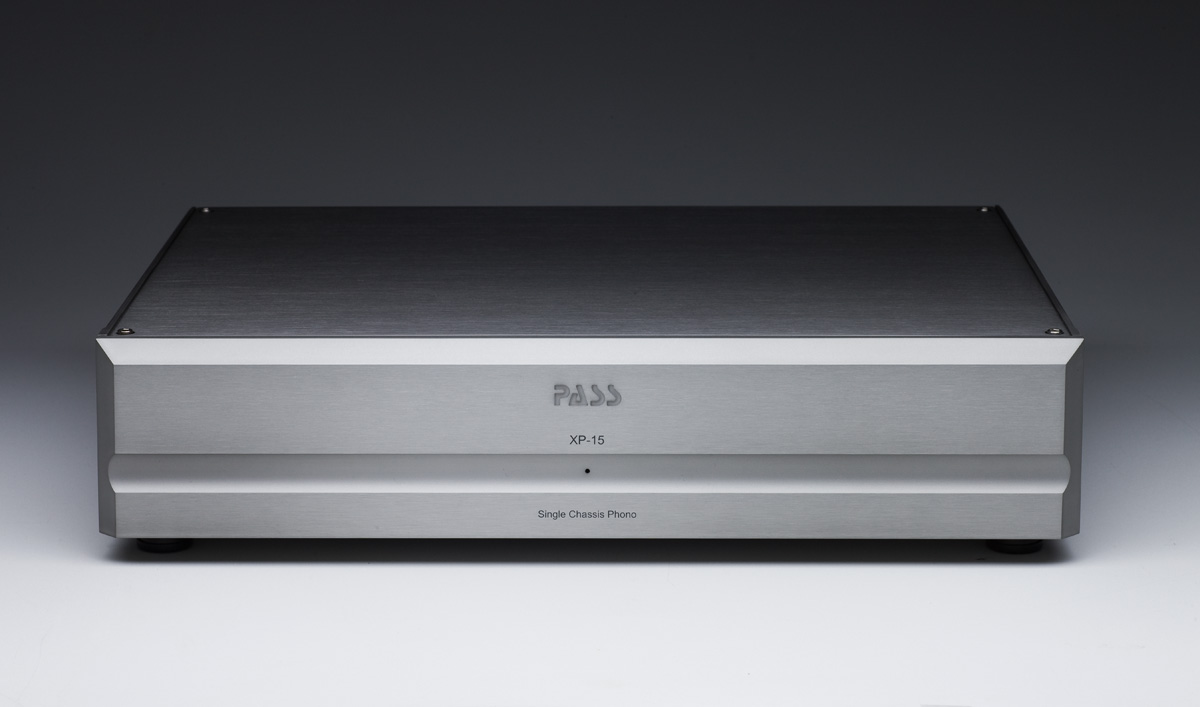
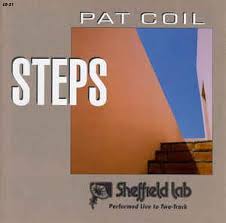 After a few days of getting the measure of the HP10 I couldn’t help but put it through a comparison with my reference Pass Labs XP-15 solid-state phonostage ($3,800.00). I began by listening to an album that I have listened to on my XP-15 for years, Pat Coil’s “Steps” [Sheffield Lab]. This 180 gram vinyl pressing is loaded with musical detail. Listening to it, first on the HP10 and then on the XP-15 yielded some not very surprising results. The opening track, “Sierra Highways,” sounded very neutral from top to bottom on the HP10. There was neither upper end brightness nor overly extended bottom end. The presentation was very natural. Through the XP-15, this same song seemed to ride that fine edge between bright and highly detailed. Because of my familiarity with its ability to carve out fine details I decided to think of it as having “extended dynamics.” Okay, it was a little bright compared to the HP10 on the top but those extended dynamics also translated into a slightly more extended and better defined bass. Of course this was really only noticeable on dynamic tracks like, The Road Less Travelled. But a track that sounded equally great with both amps was Show Your Children Love, which features splendid vocals by of R&B great Phil Perry. I love the way the HP10 breathes life into this type of vocal performance and the XP-15 renders his voice with finely edged detail.
After a few days of getting the measure of the HP10 I couldn’t help but put it through a comparison with my reference Pass Labs XP-15 solid-state phonostage ($3,800.00). I began by listening to an album that I have listened to on my XP-15 for years, Pat Coil’s “Steps” [Sheffield Lab]. This 180 gram vinyl pressing is loaded with musical detail. Listening to it, first on the HP10 and then on the XP-15 yielded some not very surprising results. The opening track, “Sierra Highways,” sounded very neutral from top to bottom on the HP10. There was neither upper end brightness nor overly extended bottom end. The presentation was very natural. Through the XP-15, this same song seemed to ride that fine edge between bright and highly detailed. Because of my familiarity with its ability to carve out fine details I decided to think of it as having “extended dynamics.” Okay, it was a little bright compared to the HP10 on the top but those extended dynamics also translated into a slightly more extended and better defined bass. Of course this was really only noticeable on dynamic tracks like, The Road Less Travelled. But a track that sounded equally great with both amps was Show Your Children Love, which features splendid vocals by of R&B great Phil Perry. I love the way the HP10 breathes life into this type of vocal performance and the XP-15 renders his voice with finely edged detail.
You would be seriously happy with either of these units, but probably for different reasons. Those of you who prefer the warm euphonics that only tubes can render from vinyl will find the HP10 hard to beat at any price, but at $3,300.00 its just a silly-good bargain. But if you like getting well-defined music out of every nook n’cranny of your recordings, the Pass unit may be a must.
Conclusion
The JE Audio HP10 phono amp is what high-end audio is all about. It’s an innovative blend of solid-state circuitry that ensures signal clarity with the life-giving magic of tubes at the output stage. It’s wonderfully built, thoughtfully designed and fully adjustable to accommodate a wide variety of cartridges and analog systems.
Tubeophiles rejoice! The HP10 will satisfy your love of those things that you enjoy most about tubes, especially if you’re still a vinyl devotee. I’m afraid though that I can’t guarantee that it will get any kind of high or be made to feel, “like being cradled to sleep by…” Uh, you know what I mean. Highly recommended.


dave thomas
Specifications:
Price: $3,300.00
Product Design
A stereo MM/MC phono amplifier with passive RIAA equalizer employing low noise semiconductors for signal amplification and a 6H30 tube output buffer amplifier.
Input: One set for MM and one set for MC
Output: One set of unbalanced and one set of balanced output
MM Gain:35, 40, 45dB for unbalanced output and additional 6dB for balanced output
MM Input Impedance: 1k, 22k, 47k, 68k, 100k Ohm
MC Gain: 60, 65, 70dB for unbalanced output and additional 6dB for balanced output
MC Input Impedance: 10, 33, 100, 250, 500 Ohm
RIAA Deviation: 20 – 20,000Hz, ±0.3dB (for MM and MC)
Subsonic Filter: -12dB/octave, 20Hz
Distortion: 0.05%
Output Impedance: 300 Ohm for unbalanced output, 600 Ohm for balanced output
Minimum Load Impedance: 10k Ohm
Signal To Noise Ratio: 70dB for MC, 85dB for MM
Power Consumption: 40W
Dimension: 143 x 450 x 392mm (H x W x L)
Net Weight: 11.6kg /25.6 pounds
Contact:
JE Audio
Unit L, 5/F, Block 1
International industrial Center
2-8 Kwei Tei Street
Fotan, Shatin
Hong Kong
Phone: (852) 3543-0973
Fax: (852) 3543-0971
E-mail: info@je-audio.com
Website: www.je-audio.com
Stereo Times Masthead
Publisher/Founder
Clement Perry
Editor
Dave Thomas
Senior Editors
Frank Alles, Mike Girardi, Russell Lichter, Terry London, Moreno Mitchell, Paul Szabady, Bill Wells, Mike Wright, and Stephen Yan,
Current Contributors
David Abramson, Tim Barrall, Dave Allison, Ron Cook, Lewis Dardick, John Hoffman, Dan Secula, Don Shaulis, Greg Simmons, Eric Teh, Greg Voth, Richard Willie, Ed Van Winkle, Rob Dockery, Richard Doran, and Daveed Turek
Site Management Clement Perry
Ad Designer: Martin Perry





Be the first to comment on: JE Audio HP10 Phono Amplifier